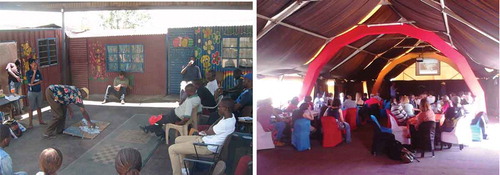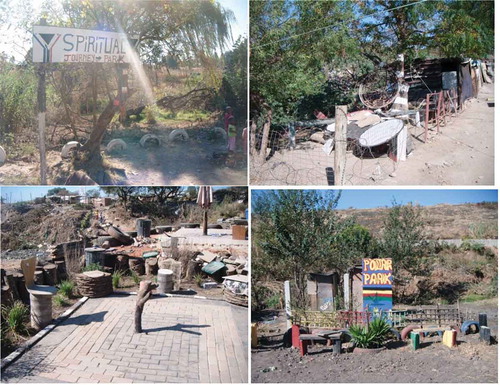ABSTRACT
In urban areas, green spaces and natural ecosystems can be a source of benefits to different socio-economic classes of residents, including those within unplanned informal settlements. Using a qualitative research approach, this study brings to light some of the existing green infrastructure (domestic gardens, informal parks, open spaces, stream with wetlands and the riparian corridor) in Kya Sands informal settlement in Johannesburg. It shows the way residents utilise green infrastructure and perceptions of their usefulness. The relevance of green infrastructure in the context of informal unplanned settlements became clearer. In the absence of state interventions, self-help initiatives in greening were observed in the study. Productive collaboration with the state and relevant non-governmental organisations is necessary for upgrading and to overcome limitations of individual initiatives within the community. The paper contributes to the growing body of knowledge on greening in low-income, informal and unplanned urban environments.
1. Introduction
Green spaces and natural ecosystems are a vital resource in cities. Their functioning as urban green infrastructure can be a source of benefits to different socio-economic classes of residents within urban areas. They can also involve some negative and undesirable aspects (Lyytimaki and Sipila Citation2009). Informality is a notable character in the way people relate with nature in cities. Across developing countries, informal settlements are often established near streams, on river banks, within or by wetlands, on steep hillsides or servitudes, buffer strips and other forms of interstitial space (Huchzermeyer Citation2011; Kohli et al. Citation2012; Adegun Citation2017). Such spaces may be of ecological significance and biodiversity wealth. In course of undertaking various activities, informal settlers also encroach on formal green spaces, especially urban parks (Bhattacharya Citation2014; Israt and Adam Citation2017).
There has been increasing attention to green infrastructure in recent literature on urbanism in sub-Sahara Africa and developing countries generally. Scholars have examined green infrastructure in the context of low-income urban contexts, especially within formally planned (but low-income) townships in South Africa (see for example, Lubbe et al. Citation2010; Cilliers et al. Citation2013; Kaoma and Shackleton Citation2014; Cock et al. Citation2016; Adegun Citation2018) and elsewhere in Africa (Mng’ong’o Citation2004; Seburanga et al. Citation2014). These studies clearly established the fact that low-income households directly depend on the natural resource environment for their lives and livelihood. For instance, Lubbe et al. (Citation2010) analysed plant diversity patterns across six urban residential typologies, including informal settlements, peri-urban formal townships and up-market neighbourhoods in Potchefstroom (South Africa). The study found that ‘a relatively strong negative relationship exists for fruit trees and socio-economic status (R2 = 0.65), suggesting that poorer households grow more fruit trees’ to avoid dependence on market products, gain additional income and improve livelihoods (Lubbe et al. Citation2010, p. 907).
Only a few studies have considered greening and natural ecosystems in the context of informal unplanned settlements in South Africa (for example, Sachikonye et al. Citation2016; Dalu and Shackleton Citation2018) and elsewhere in Africa (Waters Citation2013; Roy et al. Citation2018). Sachikonye et al. (2016) show that a NGO’s Trees for Homes Programme in Zandspruit settlement (Johannesburg) promoted some aspects of sustainable livelihoods among the poor residents. The programme’s success, sustainability and upscaling were however detracted through politically influenced and uncertain development trajectory for the informal settlement. In their survey of informal unplanned settlements within three South African towns, Dalu and Shackleton (Citation2018) found that ‘natural resources contributed up to 70% to recovery of households from flood shock’. These resources were mostly utilised for reconstruction of housing damaged through flooding. From four informal settlements in Dar es Salaam in Tanzania, Roy et al’s (Citation2018) identified, among others, innovative individual initiatives related to green infrastructure. Although ‘access to external support for informal communities has remained consistently low, … practices employed by informal dwellers show determination, ingenuity and capacity for collective action’ (ibid:291.).
More knowledge about green infrastructure within informal unplanned settlements in South Africa is needed. This is necessary to counter the historical notion among some urbanists that the ‘consideration of bio-physical conditions is something of a luxury in these [informal] areas’, and therefore not important (Quilan and McCarthy Citation1995, p. 95). By establishing its importance, this study contributes towards broader debates in wider literature on the intersections between environmental sustainability/climate change adaptation and urban informality/poverty. There is growing recognition that global green agendas must engage with the informal sector, a ubiquitous character within cities in developing countries (Smit and Musango Citation2015; Brown and McGranahan Citation2016; Hardman et al. Citation2018). Inclusive, sustainable, resilient and safe forms of housing and urban development in developing countries, as targeted in the global Sustainable Development Goal 11, cannot be achieved without engagement with this sector. Informal unplanned settlements are a notable form of urban shelter for the majority poor residents in African cities and therefore cannot be overlooked.
This paper is based on a study of Kya Sands informal settlement. The settlement accommodates poor individuals and socio-economically weak households and is presently one of the largest informal unplanned settlements in Johannesburg, South Africa. The settlement contains small pockets of green spaces. A stream, with wetlands, flow through Kya Sands settlement. These ecological characteristics provide opportunity to investigate different dimensions of the residents’ relationship with green spaces and natural ecosystems. After presenting information about the emergence, growth and level of basic services in the settlement, the paper explains methods used for data collection in the study area. Through its description and discussion on types of green infrastructure in the settlement – gardens, ‘parks’, a sports field – the traversing North Riding stream (its riparian space and wetlands), this study attempts to contribute to the growing body of knowledge on greening in low-income, informal and unplanned urban environments.
2. Study area
Kya Sands informal settlement (named after the neighbouring Kya Sands industrial area) is located about 36 km north of Johannesburg’s Central Business District (CBD). It sits on publicly and privately owned land. It lies to the east of the industrial area. An old landfill sits to the south and the middle-class Bloubosrand residential area is to the south-east (see ). The North Riding Stream, also known as Kya Sands Spruit, flows through it. This stream, ‘which has been classified as non-perennial becoming perennial’ is a tributary of the northerly flowing Klein Jukskei River and part of Johannesburg’s Jukskei catchment (Geozone Geoservices Citation2013, p. 4). The stream’s wetland, flora and fauna it contains, the riparian corridor as well as non-riparian green spaces (e.g. domestic gardens) give a natural ecosystem dimension to the informal settlement. This provides opportunity to investigate the role and potentials of green infrastructure in the area.
Figure 1. Kya Sands settlement’s boundary, surrounding areas and the North Riding stream.
Image adapted from Google Satellite Map of December 2015.
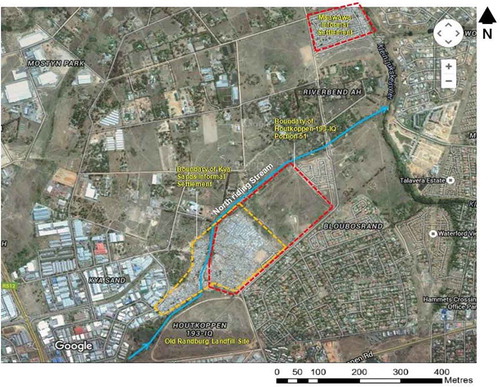
What is now known as Kya Sands settlement started around 1989 as informal shelter for people working in the old landfill site (Weakley Citation2013). The workers occupied vacant land to the west of the stream. In the recollection of a resident, the settlement started in 1990 with about 169 people (personal communication, Resident 6, 31 May 2014). In 2007, the municipality (City of Johannesburg) estimates that over 7500 people live in 1200 dwelling units in the settlement (CoJ Citation2007a). More recent statistics shows that Kya Sands settlement contains over 16,238 people, living in about 5325 dwellings that accommodate not less than 3000 households (Professional Mobile Mapping Citation2009; Huchzermeyer et al. Citation2014).
From 2007, the municipality has been providing interim services – limited potable water, sanitation and waste removal. Forty-eight communal taps, 12 stationary water tanks and 120 toilets were installed in 2007. Additional 18 standpipes were installed in 2014 (City of Johannesburg Citation2007a; personal communication, Kya Sands Community leader, 14 November 2014). Chemical (plastic) toilets and Ventilated Improved Pit Latrines (VIPs) are the two types of toilets available in the settlement. Dwellings within demarcated stands usually have a VIP toilet within the stand. In areas where there is little space between shacks/dwellings or within stands, chemical toilets are provided in open spaces, for easy access. High-mast lights placed in a few locations provide limited public space illumination. These services are insufficient when compared with the settlement’s total population. Frustrations with poor service delivery within the settlement have been expressed through protests and other forms of targeted disruptions, as reported in the media (Nicolson Citation2012; Lindeque Citation2013).
3. Research methods
This study draws on qualitative methodology and research methods. Qualitative methodology allows various strategies of inquiry and iterative steps in data collection and analysis for this kind of topic being considered (Creswell Citation2009). This methodology can lead to well-nuanced results. There were in-depth semi-structured interviews with 13 residents and 8 key informants as well as transect walks with residents. Involvement in pedagogic activities within the informal settlement also supported data collection.
The residents interviewed were selected through random sampling. The residents interviewed were spread across different sections of the settlement to ensure views from each part are represented. Four persons who live close to the stream were purposively selected within the random sample. The key informants are persons involved with interventions within informal settlements and those knowledgeable on environment-related issues in Johannesburg and South Africa at large. These persons are non-residents of the settlement. In addition, this research utilised transect walks with volunteer residents to ‘connect what participants say with where they [talked about]’ (Jones Citation2008, p. 1) and prompt conversations about histories, constructs and expectations that did not emerge through the in-depth interviews. In total, three transect walks were held – two in 2014 and one later in 2015.
During fieldwork, the author was part of the teaching cohort for a second-year Undergraduate course on ‘Contemporary Design and Environmental Issues’ and an International Transdisciplinary Workshop on ‘Reshaping Socio-ecological landscapes through collaborative practices’. Broadly, the course and workshop involved attempts to develop and fine-tune community-initiated vision for socio-ecological improvements in the informal settlement. Community meetings (see ), field trips, class presentations, studio work and other pedagogic activities forming part of the author’s participation in the two events were useful for data collection and deepened the author’s engagements in the settlement.
4. Components of green infrastructure in Kya Sands settlement
4.1. Domestic gardens
In this context, gardens refer to vegetation and vegetated spaces within stands. These range from plants in containers arranged around a shack’s plinth to a few square metres of vegetation on the ground (see ). The gardens are usually irrigated with water from communal taps and rarely with water from the stream. A link between demarcated plots and the type of gardens included was observed. There are smaller and fewer gardens around dwellings that do not have demarcated stands. Plants in containers around a shack’s plinth are the common type of garden in such situation.
Figure 3. Some of the domestic gardens in Kya Sands Settlement.
Source: Author’s Photographs, May/June 2014.
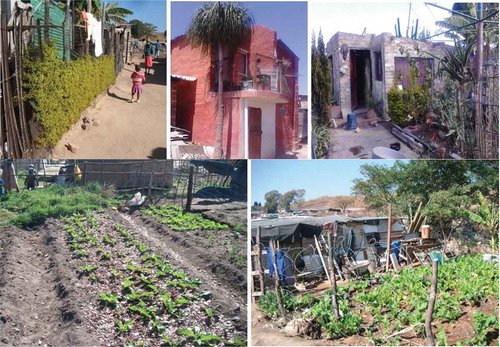
The domestic gardens serve various purposes. They provide food. An interviewee said: ‘we cook some, some are taken by people [with permission, but] I don’t sell them’ (personal communication, Resident 9, 6 June 2014). The contribution of gardens to household food consumption in the settlement is meagre because not all households have a garden. Harvests are generally in small quantities, a situation that resonates with van Averberke’s (Citation2007) findings that domestic gardeners in Pretoria settlements harvested 1.7 kg of fresh food in a month – a meagre 6.7% of a household’s recommended monthly vegetable food intake. Notwithstanding, the possibility of monetary gains still motivates some residents. A resident has plans to ‘grow these trees, chop them up, sell them for firewood or build with them’ (personal communication, Resident 2, 30 May 2014) while another one hopes to ‘make vegetable gardens and plant vegetables to sell in order to generate income. People do love vegetables here’ (personal communication, Resident 7, 6 June 2014). If residents’ tenure in the settlement is secured, ‘I will grow food (maybe cabbages), and since I have gardening experience, I would grow, cut and sell them’ (personal communication, Resident 10, 6 June 2014), another retorted.
Gardening in Kya Sands is typically a leisure-time activity as no resident reports it as primary occupation. The gardens contribute aesthetics, thus enhancing psychological well-being. Notwithstanding the nature of shacks or size of respective stands, some grow plants to beautify their immediate environment (). Since ‘they [plants] smell nice and I just love them’, a resident declared that he ‘uses the [plant] leaves for indoor fragrance or … as medicine’ (personal communication, Resident 10, 6 June 2014). Some gardens are artistic, thus serving as a means of creative self-expression that fosters a sense of attachment to place.
Temperature and wind (micro-climate) control benefits were also reported. Some interviewees associate trees in gardens with fresh air, believing that ‘when it’s hot, it releases [cool breeze, so] we sit under the trees … to benefit from oxygen’ (personal communication, Resident 8, 6 June 2014). They also acknowledged that trees around the shack protect its roofing sheets – preventing them from flying off during strong winds.
Certain factors hamper successful domestic gardening in Kya Sands settlement and full realisation of its benefits. Insufficient or outright lack of space is the most reported obstacle. There is a popular notion among the residents that once you have space, you will have a garden. A resident says ‘if I have space I would have a few plants: But when you don’t have space you don’t even think of things like that’ (personal communication, Resident 3, 31 May 2014), another believes ‘I would benefit from having my own garden through the provision of bigger plots’ (personal communication, Resident 4, 31 May 2014). A resident feels that ‘though they can’t build us the houses but give us space where you know this is my space, I can do everything’ (personal communication, Resident 2, 30 May 2014). They hinge their fulfilment in gardening on acquiring more space.
4.2. Benefits from communal gardens
As at late 2014, there were two communal gardens in Kya Sands settlement. The first one – Thandanani garden started in 2007 as a church-funded project initiated by a collection of vulnerable (orphans, HIV-affected) people living in Kya Sands and nearby Msawawa settlements. The 18 Kya Sands residents (16 women and 2 men) who started the communal garden came together due to need for mutual support and transport fare to attend treatment at clinics. The 180 sqm garden is located on the settlement’s western edge (see ). The support group members generally worked there between 8 am and 2 pm, planting cabbage, spinach, maize and tomatoes. Products from the garden were either consumed by the members or sold in the settlement. Sales did not yield much, as there are days ‘only two people would buy, and maybe [we’ll] make R12 that day’ (personal communication, Resident 11, 6 June 2014). Membership dropped as people found employment and the garden eventually closed.
Figure 4. Location of communal gardens, parks and soccer pitch in Kya Sands settlement.
Source: Google Satellite Image, November 2015.
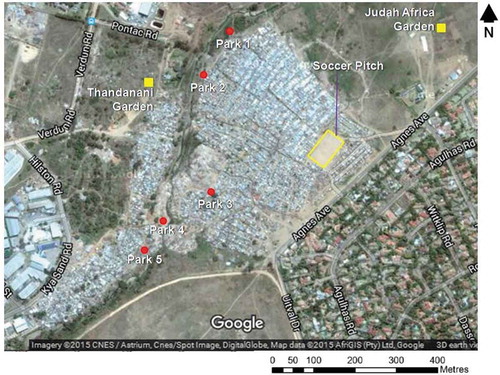
Early in 2015, a children-focussed non-for-profit organisation started operating in the settlement. It developed a creche facility in a location close to the defunct garden within Kya Sands settlement. The organisation started operating the abandoned garden space to grow food which, during the field work, solely contributes to the crèche’s mid-day meal.
The second communal garden in Kya Sands started in early 2015. It was established by a not-for-profit affiliate of a Christian Ministry that has been operating in the settlement since 1998. The garden is part of the NPO’s proposed agricultural programme intended to socio-economically uplift Kya Sands residents. Presently, food from the garden goes into the NPO’s weekly community kitchen where children from Kya Sands are fed (Kamp Citation2015). As at the time of field work, gardening activities are mainly undertaken by volunteers who come from various areas in Johannesburg. Participation from interested Kya Sands residents is also welcomed.
The two communal gardens are productive, materially and socially while serving to improve quality of life and environmental quality in the settlement. As Thandanani garden shows, regular meetings, working together, peer-support and mutual aspirations potentially enhanced the vulnerable group’s hopes for a better life. Volunteer participation in the gardens provides an opportunity to serve and socialise, which enhances social capital. Communal gardens’ contribution to social capital has been reported in other informal settlements locally (Kornienko Citation2013). Beyond social capital, communal gardens such as the ones in Kya Sands can support socio-ecological justice and empowerment in the context of deprivation (Ferris et al. Citation2001).
4.3. ‘Park’ initiatives
Given that Kya Sands is not formalised, and given that green open spaces are not considered interim basic services, there is no municipal provision of parks in the settlement. Responding to the absence of this amenity, residents developed vegetated outdoor spaces, herein referred to as ‘parks’, although they are not exactly what is obtainable in the formal sense of parks. Locations and pictures of the informal parks identified, numbered 1–5, are shown in and , respectively.
An individual and group of few residents usually spearhead the parks’ development. The physical construction is executed by members of household, friends and interested residents. The parks consist of basic components such as trees, shrubs, flowers, sitting area/seats and play equipment made from recycled materials and waste products like old tyres, tree trunks and timber off-cuts. The ‘parks’ are used for recreational purposes and social activities. Men gather there on weekends, they drink, ‘relax, enjoy themselves and watch soccer sometimes’, thus serving as an alternative to indoor shebeens (personal communication, Resident 4, 31 May 2014).
In some instances, self-help attempts to develop parks were derailed, because planting took place in winter – meaning that plants did not get enough rain water – and because of improper waste disposal – people disposing contaminated grey water and solid waste on plants and vandalism. A young man who, together with friends, tried but failed said ‘maybe we would have benefited if the park successfully went on. We only tried creating it. Half-way, things started getting destroyed, like the plants and tyres: before two months, everything was destroyed’ (personal communication, Resident 3, 31 May 2014).
Johannesburg City Parks and Zoo (JCPZ), the municipal entity responsible for green open spaces and parks in Johannesburg, does not contribute to these self-constructed green open spaces. The leadership of Kya Sand settlement wrote to JCPZ in March 2013 seeking its assistance with the development of green open spaces. According to the reply received ‘they cannot do anything here… they can only help with, for example, if there is a tree on the road. They can come to cut it’ because Kya Sand is not a formal settlement (personal communication, Community Leader, 31 May 2014).
Non-governmental organisations also do not support these informal parks because of the state’s policy which casts uncertainty on the permanence or temporariness of different informal settlements. Conditions attached to funding received by NGOs may not support working in such context. According to an officer at Food and Trees for Africa, his organisation ‘do not do [work] in informal settlements … because maybe the government can just come and tear off the settlement … even if we get calls [from informal settlements] we won’t be able to go and plant trees’ (personal communication, F&FTA Officer, 12 November 2014).
Access to these small parks is in some cases restricted. In certain instances, access is denied to certain groups of people. For example, Limpopo mini-park does not admit women (see ). Park 5 (below left in ) is being developed by an entrepreneur (a resident) who proposed a charge for users. The fixtures in some do not make them child-friendly. Park 4 (top right ) is bordered by barbed wires which is not safe for children. Although they contribute to environmental sustainability, the exclusionary tendencies of these parks can be linked to the socio-economic setting. For example, using parks for income generation emerges from a need to recover cost or as livelihood strategy. Child-friendly fixtures would cost what the informal developers or poor residents might be unable to afford. Given the socio-economic setting, one may not expect too much around inclusion from these self-help initiatives at the local level.
Figure 6. Signage at the Limpopo Mini-park in Kya Sands settlement.
Source: Author’s Photograph, June 2014.
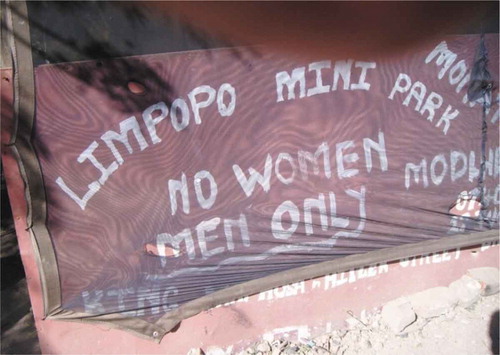
That no substantive green space intervention is made or existing self-help efforts supported by the municipality or NGOs excludes the residents from benefits associated with formal green spaces. ‘Informal’ labelling of the settlement in terms of municipal services is not just exclusionary but problematic. It perpetuates historical disadvantage and makes existing injustices fester. Social and environmental justice cannot be achieved if the state and NGOs do not play appropriate roles on green infrastructure in informal settlements.
4.4. The local soccer pitch
There is an open space used in the evenings and on weekends mainly for football activities in the settlement. Like most soccer pitches in informal settlements, this open space is not vegetated (see ). Any grass seeding there cannot grow because it is trampled on by the sportsmen and spectators. It is a notable recreational space that contributes to social life. As a valuable space that facilitates community cohesion, it has not been encroached upon as the settlement expanded. Different categories of people (men and women, young and old) freely gather around the pitch to watch and partake in sporting activities (see ).
4.5. The North Riding stream and riparian corridor
The North Riding stream is a notable ecological resource in the community, providing a range of products and services to the residents. It was the main source of water when the settlement was established. Speaking of the late 1980s and early 1990s, one of the first residents said ‘the river was smaller … we were still able to wash our clothes and bath ourselves with water collected there, unlike now when it is polluted’ (personal communication, Kya Sands Resident 6, May 2014). Change in the size of the stream, in terms of higher flow, is likely to be the result of upstream development that led to reduced opportunities for water seepage into the soil, meaning increased run-off into the stream. At the time of field work, some residents still used the stream to complement water supply accessed via communal standpipes. When there is no water from the taps, the stream provides water for irrigation. Although only a resident said he ‘scoops some with a bucket to water a few of our plants’ (personal communication, Kya Sands Resident 7, 6 June 2014). Water from the stream is used to prepare mortar and concrete during construction. Laundry and other washing also take place in the stream (see ).
Figure 8. Residents washing paint containers in the stream next to a dumping area.
Source: Author’s Photograph, November 2014.
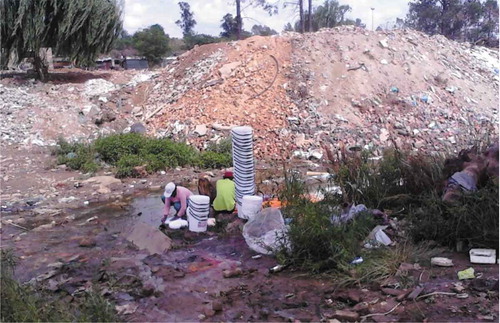
Apart from water, residents also derive other benefits from the stream. Early occupants harvested reeds from the wetlands to roof huts they lived in (personal communication, Resident 6, May 2014). Sand (fine aggregate) used to prepare concrete/mortar for plastering is excavated from the streambed. The stream supplements available sanitation – making up for the locational disadvantages of toilets and absence of proper drainage. Residents living in shacks/stands without a toilet or those passing by urinate in the riparian corridor. Used sanitary items such as toilet paper (or its common substitute, newspaper), nappies/diapers as well as human excrement are disposed directly into the stream. Grey water is also emptied into the stream. A resident admitted that ‘we use it like, as everything; as you can see, it is used as the dumping area, like a dust bin and as a drain’ (personal communication, Resident 3, 31 May 2014).
Construction and gardening companies regularly dump waste materials such as sawn tree trunks and rubble in the riparian corridor and wetland (see ). Although disconcerting from an ecological view, some residents have an informal arrangement with the companies to dump for free or amounts much lower than should have been paid at official dump sites because materials can be salvaged (Kamp Citation2015). The police are aware of this but were not halting dumping probably because of the material benefits involved (personal communication, Kya Sands Community leader, September 2015). Residents salvage timber from the dump site and use it as fuel for cooking and heating. Entrepreneurs salvage bricks from the dumps, clean these of cement and sell them for construction in the settlement. A stack of 1000 cleaned bricks could sell for R1000 (personal communication, Resident 13, 17 September 2015). Salvaging and re-use of bricks of course is a sustainable practice, but the process in Kya Sands has gradually encroached upon the wetland and riparian corridor, limiting their functioning as green infrastructure.
Figure 9. Dumping waste in the riparian corridor and wetland in Kya Sands settlement.
Source: Author’s Photographs, May 2014.

The riparian corridor is regarded as useful for various reasons. Speaking of the time they first occupied Kya Sands, one of the residents said ‘we would chop down the trees and use the wood to build our structures. There was wildlife. We would hear them roar, but they never bothered us’ (personal communication, Resident 5, 31 May 2014). Although wildlife (non-domesticated animal species) has presently disappeared from the riparian corridor, their benignity was noteworthy. A religious group used to congregate in open space by the riparian corridor. The group fetched water, used as part of their religious rituals, from the stream, but this is no longer possible because it is now polluted.
The residents appreciate trees in the riparian corridor. Since the trees provide shade, ‘people go and sit in these spaces and enjoy themselves’, a young man said (personal communication, Resident 4, 31 May 2014). Another resident commented that ‘I sometimes go there to relax and listen to birds chirp. The things I like there are the rocks on the river bank, where I normally relax – it’s cool and quiet’ (personal communication, Kya Sands Resident 10, 31 June 2014). The riparian space also serves as a play area for children (see ), although it is not safe because of the stream’s polluted condition and collapsed bank.
Figure 10. Children playing in the Stream while a resident collects water.
Source: Author’s Photograph, May 2014.
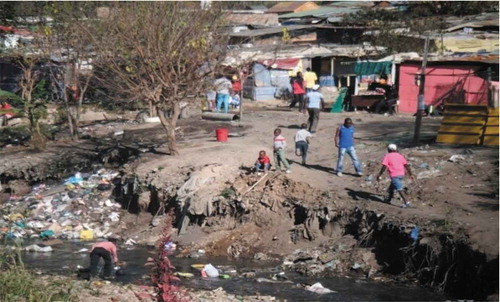
While most of the afore-mentioned activities leave the stream polluted, pollutants also enter from upstream – from the adjoining Kya Sand industrial area. These decimates the stream’s capacity and functioning as a natural ecosystem within and outside the settlement.
5. Implications of green infrastructure’s contribution in the settlement
The identified gardens within Kya Sands informal settlement are sources of food while the stream provides water. Due to absence of electricity, firewood (for fuel) is harvested from trees within and around the settlement. In line with Wallace (Citation2007), the residents place more demand on components relating to basic resources – food, water, energy. The means that the Kya Sands case enriches what is already known in literature – that low-income households depend directly on the natural resource environment for their lives and livelihood (Nadkarni Citation2000; Cilliers et al. Citation2013; Waters Citation2013).
Transactions associated with the communal gardens contribute to social capital within the settlement. By creating spaces for face-to-face interactions which promotes social cohesion among vulnerable residents or otherwise, the gardens are a useful route to community resilience. This outcome concurs with Birtchnell et al. (Citation2018) who identified meeting social needs as one of the notable benefits of urban green infrastructure within Dakar’s slums. Affirmation of masculinities through exclusion of women in one of the parks, though not new in South Africa’s informal settlements (Gibbs et al. Citation2014), appears contradictory to this benign social milieu. It must not be encouraged, as it stands.
In situ interventions, if considered for Kya Sands settlement, could explore substantive contribution from formally developing components of green infrastructure. The sports field is a space that fosters inclusion and can enhance quality of life. It can be properly vegetated. In this situation, it can provide temporary storage for run-off after precipitation, thus complementing any form of drainage infrastructure available. Greening the field, however, must consider local realities and not disrupt the residents’ connections to it. Le Roux’s (Citation2014) explained that, after an informal soccer pitch in Kwathema Township (East Johannesburg) was vegetated by the government, it rapidly fell into disuse because of erratic maintenance and the bureaucratic outside control that ensued. The wetland could be cleaned and reconstructed to restore the ecosystem as well as enhance its flood control and water purification capacities. The riparian corridor can be vegetated. According to Langergraber (Citation2013), these interventions can be simple to maintain and can also be cost-effective.
The residents complained about space limitations. They believe that with increased plot size, they can have domestic gardens. But is more space possible, with increasing pressure on limited land available for housing development in many cities? With ongoing densification across low-income urban communities in South Africa (Lategan and Cilliers Citation2016; Todes et al. Citation2017), it appears that average plot sizes and curtilage space will continue to decrease. This situation calls for creative techniques of low- and no-space plant growing technologies. Low-cost, do-it-yourself vertical farming systems are needed. However, the uptake of such low-space greening systems where only little space is available must be deliberately encouraged.
The residents’ individual initiatives on greening, though commendable, are still inadequate. Using the words of Roy et al. (Citation2018), they are ‘commonly acquiescence and coping’, and not absolutely ‘progressive or transformative’. Their limitations are apparent when considering broader issues of sustainability, social justice, upscaling and service delivery. The state and third sector need to constructively intervene to aid these self-help efforts. For example, exclusionary tendencies manifest in one of the park’s no-access to women can be addressed through this means. Based on the examples of small-scale, temporary initiatives conceived and led by individual residents in the community, interests and resources of the residents can be leveraged through productive collaboration to ‘green’ the informal unplanned settlements.
6. Conclusion
This study brings to light some of the existing green infrastructure (domestic gardens, informal parks, open spaces, stream with wetlands and the riparian corridor) in the Kya Sands informal settlement. It shows the way people relate with green spaces and natural ecosystems as well as perception of their usefulness to their lives and livelihoods. The relevance of green infrastructure in the context of low-income informal unplanned settlements has become clearer, through the Kya Sands settlement case.
Self-help initiatives in greening, in the absence of state interventions, is a key issue emerging from this case. Though disadvantaged socio-economically, individuals and households in informal unplanned settlements see green spaces as an amenity. As a result, they deploy resources that assist in addressing its absence in the community. This shows some potentials for residents-led urban greening and environmental management in low-income communities. But it also usually comes with drawbacks. Resources available to the residents are limited, while their precarious living conditions could make certain thrusts ephemeral. Productive collaboration with the state and non-governmental organisations can aid and upgrade these limited self-help initiatives within the community. An inclusive and sustainable urban future cannot evolve without this consideration.
Disclosure statement
No potential conflict of interest was reported by the author.
Additional information
Notes on contributors
Olumuyiwa Bayode Adegun
Olumuyiwa Bayode Adegun is a lecturer in the Department of Architecture, Federal University of Technology, Akure, Nigeria and Visiting Research Fellow in the School of Architecture and Planning, University of the Witwatersrand, Johannesburg, South Africa. Research interests include informal settlements, housing, green infrastructure, and urban renewal.
References
- Adegun OB. 2018. Residents’ relationship with green infrastructure in Cosmo City, Johannesburg. J Urbanism: International Research on Placemaking and Urban Sustainability. 11(3):329–346.
- Adegun OB. 2017. Green infrastructure in relation to informal urban settlements. J Archit Urbanism. 41:22–33.
- Bhattacharya R. 2014. The informal sector the role of urban commons. Yojana. 58:46–48.
- Birtchnell T, Gill N, Sultana R. 2018. Sleeper cells for urban green infrastructure: harnessing latent competence in greening Dhaka’s slums. Urban For Urban Green. doi:10.1016/j.ufug.2018.05.014
- Brown D, McGranahan G. 2016. The urban informal economy, local inclusion and achieving a global green transformation. Habitat Int. 53:97–105.
- Cilliers S, Cilliers J, Lubbe R, Siebert S. 2013. Ecosystem services of urban green spaces in African countries-perspectives and challenges. Urban Ecosyst. doi:10.1007/s11252-012-0254–3
- City of Johannesburg. 2007a. Action to provide short and long term solutions for the Kya Sands informal settlement in region A. Johannesburg: City of Johannesburg.
- Cocks M, Alexander J, Mogano L, Vetter S. 2016. Ways of belonging: meanings of “nature” among Xhosa-speaking township residents in South Africa. J Ethnobiol. 36(4):820–841.
- Creswell J. 2009. Research design: qualitative, quantitative and mixed methods approach. 3rd ed. Thousand Oaks: Sage.
- Dalu MT, Shackleton CM. 2018. The potential use of natural resources in urban informal settlements as substitutes for financial capital during flooding emergencies. Phys Chem Earth. doi:10.1016/j.pce.2018.03.002
- Ferris J, Norman C, Sempik J. 2001. People, land and sustainability: community gardens and the social dimension of sustainable development. Social Policy Admin. 35(9):559–568.
- Geozone Geoservices. 2013. The results of geotechnical investigation for a pedestrian bridge at Kya Sands. Hilton: Gauteng. Geozone Geoservices.
- Gibbs A, Sikweyiya Y, Jewkes R. 2014. ‘Men value their dignity’: securing respect and identity construction in urban informal settlements in South Africa. Glob Health Action. 7(1):23676.
- Hardman M, Chipungu L, Magidimisha H, Larkham PJ, Scott AJ, Armitage RP. 2018. Guerrilla gardening and green activism: rethinking the informal urban growing movement. Landsc Urban Plan. 170:6–14.
- Huchzermeyer M. 2011. Cities with slums: from informal settlement eradication to a right to the city in Africa. Cape Town: UCT Press.
- Huchzermeyer, M., Karam, A., and Maina, M.2014. Informal Settlements. In: Harrison, editor. Changing space changing city: Johannesburg after apartheid. Johannesburg: Wits University Press; p. 154–171.
- Israt AS, Adam M. 2017. An investigation of physical attributes relevant to the informal street Hawking in the urban spaces of Dhaka City. J Des Built Environ. 17(1). doi:10.22452/jdbe.vol17no1.5
- Jones P, Bunce G, Evans J, Gibbs H, Hein J. 2008. Exploring space and place with walking interviews. J Res Practice. 4(2):D2. www.http:jrp.icaap.org/index.php/jrp/article/view/150/101
- Kamp C, 2015. With feet on the ground: building a sustainable socio-economic community centre in Kya Sands. Talk presented at international transdisciplinary workshop, University of the Witwatersrand, Johannesburg. 14 September.
- Kaoma H, Shackleton C. 2014. Collection of urban tree products by households in poorer residential areas of three South African towns. Urban For Green. 13:244–252.
- Kohli D, Sliuzas R, Kerle N, Stein A. 2012. An ontology of slums for image-based classification. Comput Environ Urban Syst. 36(2):154–163.
- Kornienko K, 2013. Engaging informal settlements as landscapes of place: reconceptualising urban communities in the struggle for in situ upgrading. PhD Thesis, University of the Witwatersrand, Johannesburg.
- Langergraber G. 2013. Are constructed treatment wetlands sustainable sanitation solutions? Water Sci Tech. 67(10):2133–2140.
- LateganLG, Cilliers JE. 2016. Towards more compact South African settlements through informal housing: The case of backyard densification in Bridgton and Bongolethu, Oudtshoorn. Town and Regional Planning. 68:12–26.
- Le Roux H, 2014. Lived modernism: when architecture transforms. Doctor of Architecture Dissertation, Katholiek University Leuven.
- Lindeque M, 2013. Kya Sand protesters disperse. Eyewitness News, 11 September.
- Lubbe C, Siebert S, Cilliers S. 2010. Political legacy of South Africa affects the plant diversity patterns of urban domestic gardens along a socio-economic gradient. Sci Res Essays. 5(19):2900–2910.
- Lyytimaki J, Sipila M. 2009. Hopping on one leg – the challenge of ecosystem disservices for urban green management. Urban For Urban Green. 8:309–315.
- Mng’ong’o O. 2004. A browning process.The Case of Dar es Salaam City. Doctoral Thesis, Division of Urban Studies, Stockholm University, Sweden.
- Nadkarni M. 2000. Poverty, environment, development – a many patterned nexus. Econ Polit Wkly. 35(14):1184–1190.
- Nicolson G, 2012. The broken vows and blocked roads of Kya Sands, Daily Maverick, 27 March.
- PMM. 2009. Socio economic survey, Johannesburg North: Kya Sands and lion park informal settlements. Bedfordview: Professional Mobile Mapping.
- Quilan T, McCarthy J. 1995. Is integrated environmental management feasible in the informal settlements of South African cities? Urban Forum. 6(1):95–111.
- Roy M, Shemdoe R, Hulme D, Mwageni N, Gough A. 2018. Climate change and declining levels of green structures: life in informal settlements of Dar es Salaam, Tanzania. Landsc Urban Plan. doi:10.1016/j.landurbplan.2017.11.011
- Sachikonye MT, Dalu T, Gunter A. 2016. Sustainable livelihood principles and urban greening in informal settlements in practice: a case of zandspruit informal settlement, South Africa. Development Southern Africa. 33(4):518–531.
- Seburanga J, Kaplin B, Zhang Q, Gatesire T. 2014. Amenity trees and green space structure in urban settlements of Kigali, Rwanda. Urban For Urban Green. 13(1):84–93.
- Smit S, Musango JK. 2015. Towards connecting green economy with informal economy in South Africa: a review and way forward. Ecol Econ. 116:pp.154–159.
- Todes A, Weakley D, Harrison P. 2017. Densifying Johannesburg: context, policy and diversity. J Hous Built Environ. 33(2):281–299.
- Van Averbeke W. 2007. Urban farming in the informal settlements of Atteridgeville Pretoria, South Africa. WaterSA. 33(3):337–342.
- Wallace K. 2007. Classification of ecosystem services: problems and solutions. Biol Conserv. 139:235–246.
- Waters J, 2013. The role of ecosystem services and adaptive capacity in the resilience of poor urban areas. PhD Thesis. University of East Anglia, Norwich.
- Weakley D, 2013. Recognising vulnerability and resilience in informal settlements: the case of Kya Sands, Johannesburg, South Africa. Master of Science in Town and Regional Planning Dissertation, University of the Witwatersrand, Johannesburg.

